| Cuzco
is by far the most beautiful Peruvian city that we visited. It is the heart of
the Inca empire, replete with history, architecture, and natural beauty. We stayed
at a hotel on this square, The Corregidor, so we were close to the night life,
the restaurants and the shops. And yes, it did rain a few times. 
|
| 
|
|
| From
Cuzco, Machu Picchu is about 4 hours away on a train--the only ground transportation
available. This train ride has to be among the most beautiful in the world, revealing
one breathtakingly gorgeous scene after another. Those backpackers who hike the
Inca Trail get off at kilometer 88, and those who want to hike the last 1/3 of
the trail get off at kilometer 104, while everyone else rides all the way to Aguas
Calientes. Below
are the train tracks in Aquas Caliente at the foot of Machu Picchu. Sadly, there
was a mud slide on the tracks about two kilometers from the town that destroyed
two houses killing some villagers several days before our visit. This necessitated
our walking the last several kilometers, around the mud slide and the wreckage
of the houses. Mud slides are fairly common here, but since tourism is the only
source of revenue for the people of Aguas Caliente, they set about cleaning up
and carrying on as best they can under the circumstances. 
 There
are lots of restaurants in Aguas Calientes; most of them have a sidewalk presence
in the daytime. Though it is high in the mountains, it is comfortably warm in
midday. |
 |
Here,
we stayed
at a delightful posada halfway up a mountain, and had this spectacular view of
Machu Picchu. |
| After
we arrived in Aguas Calientes, about noon, we checked into our hotel, ate lunch,
and then caught a bus to Machu Picchu to be there about the time most tourists
would be leaving. Below is the road from Aguas Calientes to the entrance to Machu
Picchu...it was hairpins the whole way, but the only other traffic on the road
was more buses....many many that drive back and forth on this road all day every
day. We at first held our breath, then decided that the drivers know their jobs,
so we relaxed and enjoyed the vistas. 
|
| Below,
the Inca Trail is seen as it emerges from the forest in the background. This was
the only route to the sacred site during the period of the Inca Empire, and the
favored route into the ruins by many backpackers. 
|
| As
you enter the city from the Inca Trail, this is the breathtaking view....Wayna
Picchu as the backdrop to the ruins. 
a
similar view of the sacred city in the afternoon sun.... 
The
city was probably used as a religious retreat for the royal family and their guests.
It is a city with 16 sectors of about 200 living quarters, many temples for different
occasions, agricultural terraces and grazing land for animals, fresh water fountains
and drainage. It was built over a period of 100 years or more starting in the
mid 15th century, and seemed to be a work in progress when the Inca empire crumbled
in the mid 16th century. The city was apparently abandoned before the Spanish
arrived in this area, and it was not rediscovered until the early 20th century
by Hiram Bingham. Below
is an early morning view--the mist-shrouded Wayna Picchu. 
|
| The
sacred city is set on a plateau between two mountains, Machu Picchu and Wayna
Picchu. Surrounding the ruins is the Urubamba River, the most sacred of the Inca
rivers. The
hut below is called the watchman's hut, though historians can only guess the probable
function of the various buildings and spaces. Only a few of the habitations and
buildings have been covered with thatch roofs; most of the ruins are exactly as
Bingham found them. 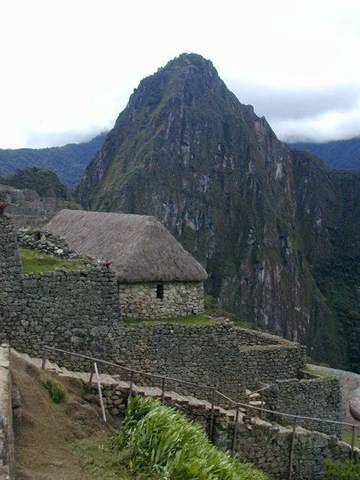
|
|
| Terraces
surround the site on three sides. The agriculture sectors were used to grow quinoa,
vegetables and fruits for the inhabitants of the sacred city, and were built so
well that even over the centuries they have not suffered from erosion or decay. 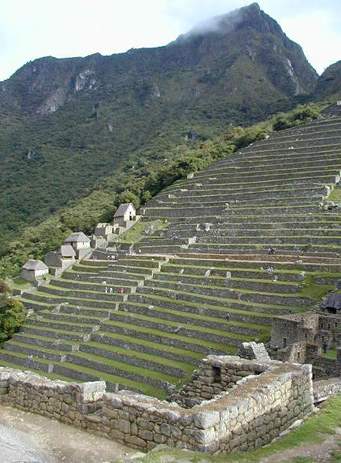
|
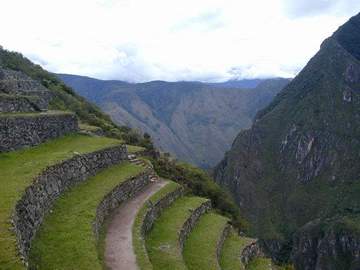
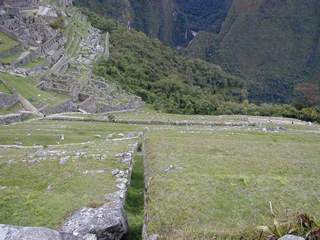
A
dry moat assists with drainage. |
| Several
architectural features unique to the Incas are seen in Machu Picchu and other
Inca ruins. First, the walls are constructed from stone that was cut, we think,
by finding natural faults and driving a wedge into the fault. 
|

There
is no mortar in these or any Inca walls....they are constructed at slight angles
to give them more strength. There are also key stones, such as the large one above,
which ties together the layers of stone
in this wall. |
| 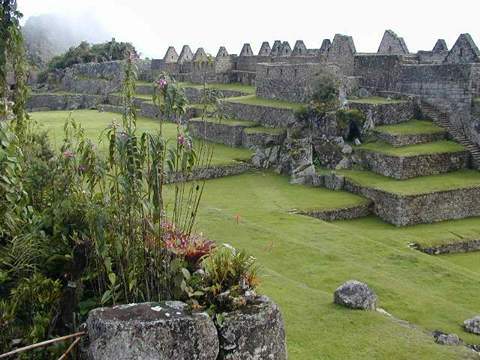
Another
feature of the walls is that their foundations are several feet or more below
ground. | 
The
llamas still graze the terraces today. |

Above,
note the larger stones on the bottom, gradually reducing in size with each successive
row. That too gives the walls great stability. This style of wall is seen in the
Inca temples and construction in Cusco as well. |
The walls of the
temples and living quarters stand much as they were in the 15th century. Only
the roofs, probably thatch, are missing. Since the Incas had no written language,
we have no records to assist us in understanding the details of construction or
use. 
|
| |

|
 It's
well worth visiting the ruins at different times of day. The early morning gives
the ruin a mysterious feel. As the mist burns off, the midday and late afternoon
sun casts shadows that change the feel of this magnificent monument. |
Another
feature of Inca architecture is the door and window treatment. Doors are used
to frame a view, such as the entrance to the sacred city, below, which frames
Wayna Picchu directly behind it. Similarly, windows frame views of the mountains
and river valley. 
| |

Note
that the doorways and the windows are not square. This angle was not a miscalculation;
rather, it gives them strength and is probably the feature most responsible for
the survival of the Inca walls. |

This
is called the Temple of the Three Windows. Each window frames a view of the mountains
in the distance. |
| |
|
| The
gravity-fed water system is another amazing engineering fete. Fresh water is delivered
via a 750 meter trough from a mountain spring. The trough is precisely the correct
depth and width to promote a constant flow without overflowing or drying up. There
are sixteen levels where the water is delivered to little bath or waterfall, the
first (therefore most pure) being at the royal family residence (below). 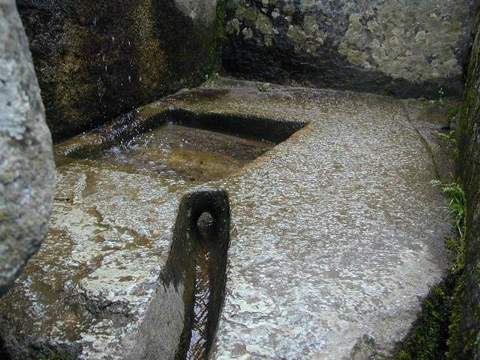
|
| Another
view of the royal well.... 
|
|
| One
of the most stunning architectural elements at Machu Picchu is the use of in
situ rocks. They have been carved or are used as they existed originally in
the temples and around the grounds. Below is a carving that mirrors the view of
Wayna Picchu and the surrounding peaks. 
|
| Funerary
Rock, below, is situated close to what seemed to have been burial grounds. Perhaps
it was used to lay out the corpse for drying before mummification, or as a bier
for the wake. Some believe it was for ritual sacrifices. We can only guess. 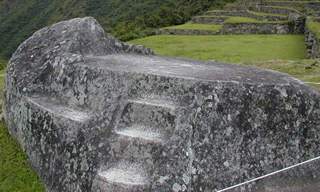
|
|
| 
And
this is (part of) the Temple of the Condor,
this in situ stone suggesting
the wing of the condor.
The temple incorporates several rocks to form the
condor.
|
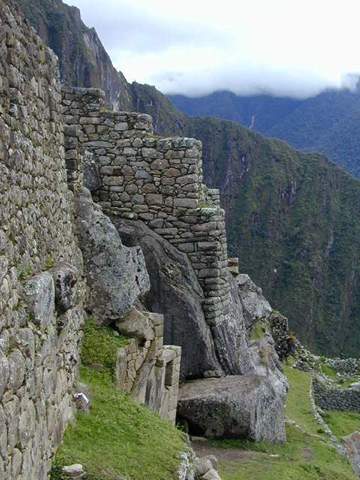 The
natural rock formations were used in this temple as well. The
natural rock formations were used in this temple as well. |
| |
The
principal temple (center) also incorporates in situ stones that form the
alter. In the distance at the highest elevation, the Intiwatana also uses such
a stone. In
the foreground is the rock quarry used to store building rocks for future growth.
It is thought that the building of the sacred city was still in progress when
the Spanish conquest put an end to the Inca Empire. |
| Taken
from Sacred Rock, the Urubamba river valley.... 
|
On
our way to Wayna Picchu... 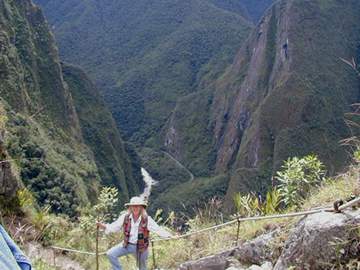
|